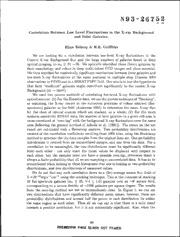
NASA Technical Reports Server (NTRS) 19930017563: Correlation between low level fluctuations in the x ray background and faint galaxies PDF
Preview NASA Technical Reports Server (NTRS) 19930017563: Correlation between low level fluctuations in the x ray background and faint galaxies
N 9 3 - 2 6 75 Correlation Between Low Level Fluctuations in the X-ray Background and Faint Galaxies. Eline Tolstoy & R.E. Griffiths We are looking for a correlation between low-level X-ray fluctuations in the Cosmic X-ray Background flux and the large numbers of galaxies found in deep optical imaging, to m < 24 —26. We optically identified these (faint) galaxies by v their morphology and colour in deep multi-colour CCD images and plate material. We then searched for statistically significant correlations between these galaxies and low-level X-ray fluctuations at the same positions in multiple deep Einstein HRI observations in PAVO and in a ROSAT PSPC field. Our aim is to test the hypothesis that faint "starburst" galaxies might contribute significantly to the cosmic X-ray Background (at ~ IkeV). We used two proven methods of correlating low-level X-ray fluctuations with optical sources: (1) For the Einstein data, we use the proven technique of "Stacking", or summing, the X-ray counts at the numerous positions of colour selected (flat- spectrum) galaxies in the field (Anderson 1985) to determine the mean X-ray flux for the class of optical sources which are stacked, as a whole; (2) For the more uniform sensitivity ROSAT data, the number of faint galaxies in a given cell area is cross-correlated at "zero lag" with the background X-ray fluctuations over the same area [following the general method of Jahoda et al. (1991)]. The errors on the net result are calculated with a Bootstrap analysis. Two probability distributions are created of the correlation coefficients resulting from 1000 tries, using the Bootstrap method to generate the the data samples from the original data set. One probability distribution is created from an uncorrelated sample, and one from the data. For a correlation to be meaningful, the two distributions must be significantly different from each other - not only must the mean values be displaced with respect to each other, but the samples must not have a sizeable over-lap, otherwise there is always a finite probability that all we are sampling is uncorrelated data. It has to be remembered when looking at these histograms that one is looking at two probability distributions, not two distributions of measured values. We do not find any such correlation down to a (3cr) average source flux limit of 3 xlO~16erg s^cm"2 using the stacking technique. This is the outcome of stacking 30 flat-spectrum galaxies (m < 25, V-I < 1.0) galaxies over an ~8' square field, v corresponding to a source density of ~1800 galaxies per square degree. The results from the zero-lag method are not so immeadiately clear. In Figure 1, we can see two distributions that have significantly different mean values, however, these are probability distributions and around half the points in each distribution lie within the same region as each other. Thus all we can say is that there is a mild trend towards a positive correlation, but it is not statistically significant. Also, when the 99 FRESCOING PAGE BLANK NOT FILMED number of blue galaxies in a given cell is plotted against the number of X-ray counts in the same cell, there is poor evidence for a correlation, and certainly not one involving more than a small percentage of the data. 200 CCD UBVI flat galaxies correla ted with x-ray fluctuations (Wxg) 150 o c <u 3 100 cr 50 0 I L -.4 .4 Figure 1: The bootstrap analysis distribution of the values of W^, the correlation coefficient calculated for samples of UBVI colour selected galaxies vs. low level X- ray fluctuations (shaded histogram), as well as the bootstrap distribution for two uncorrelated data samples W (unshaded histogram). The mean value for the noise correlation distribution, W' = 0.110, and for the uncorrelated distribution, W , xg no 3e = 1.616 x!0~3. References: Anderson S.F. (1985) PhD thesis, University of Washington Jahoda K., Lahav O., Mushotzky R.F., Boldt E. (1991) Ap.J. 378, L37 100
